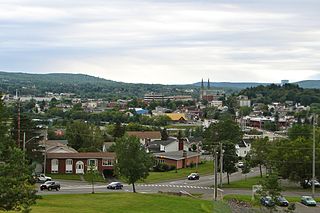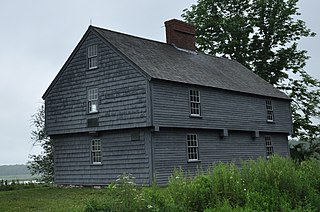
Aroostook County is a county in the U.S. state of Maine along the Canada–United States border. As of the 2020 census, the population was 67,105. Its county seat is Houlton, with offices in Caribou and Fort Kent.

Edmundston is a city in Madawaska County, New Brunswick, Canada. Established in 1850, it had a population of 16,437 as of 2021.
Saint Croix Island, long known to locals as Dochet Island, is a small uninhabited island in Maine near the mouth of the Saint Croix River that forms part of the Canada–United States border separating Maine from New Brunswick. The island is in the heart of the traditional lands of the Passamaquoddy people who, according to oral tradition, used it to store food away from the dangers of mainland animals. The island was the site of an early attempt at French colonization by Pierre Dugua, Sieur de Mons in 1604. In 1984 it was designated by the United States Congress as Saint Croix Island International Historic Site. There is no public access to the island, but there is a visitor contact station on the U.S. mainland and a display on the Canadian mainland opposite the island.
Acadian House may refer to:

Fort Kent, located at the confluence of the Fish and Saint John rivers in the town of Fort Kent, Maine, United States, is the only surviving American fortification built during the border tensions with neighboring New Brunswick known as the Aroostook War. It is preserved as the Fort Kent State Historic Site, which features an original log blockhouse that is open for visits in the summer. The fort was added to the National Register of Historic Places in 1969 and declared a National Historic Landmark in 1973.

The McIntire Garrison House is a historic house on Cider Hill Road in York, Maine. Built c. 1707, it is an extremely rare well-preserved example of a New England colonial log garrison house, built by settlers for defense against Native American attacks. The house, possibly the oldest in the state, was designated a National Historic Landmark in 1968.

The Acadian House is a historic house on Union Street in Guilford, Connecticut. Built about 1670, it is one of Connecticut's oldest surviving houses, notable for its occupation by refugee Acadians following their 1755 deportation from Nova Scotia. The house was listed on the National Register of Historic Places in 1975.
A potato house is a structure built for the storage of harvested potatoes or sweet potatoes. Such buildings were common in Sussex County, Delaware, and adjoining areas of Delaware, and Maryland in the early 20th century, when sweet potato production was at its local peak.

Longfellow-Evangeline State Historic Site, located in St. Martinville, Louisiana, showcases the cultural significance of the Bayou Teche region. It is the oldest state park site in Louisiana, founded in 1934 as the Longfellow-Evangeline State Commemorative Area. Evangeline was Henry Wadsworth Longfellow's enormously popular 1847 epic poem about Acadian lovers, who are now figures in local history. In the town center, the Evangeline Oak is the legendary meeting place of the two lovers, Evangeline and Gabriel. A statue of Evangeline marks her supposed grave next to St. Martin of Tours Church. The state historic site commemorates the broader historical setting of the poem in the Acadian and Creole culture of this region of Louisiana.

St. David Catholic Church is a historic church at 774 Main Street in Madawaska, Maine. Built in 1911, it is an architecturally distinctive blend of Baroque revival and Italian Renaissance revival architecture. The congregation was the first separate Roman Catholic congregation established in Madawaska, the result of many years' struggle, after the international border divided the French Catholic community here in 1842. The building was listed on the National Register of Historic Places in 1973.

The Levi Sargent House is a historic house at 747 Otisfield Gore Road in Otisfield, Maine. Built c. 1812, It is one of a small number of log structures to survive in Maine from the 19th century. It was listed on the National Register of Historic Places in 1987.

Maplewood Farm, also known as the Anderson-Lord House, is an historic farm property on River Road in South Windham, Maine, United States. The 135-acre (55 ha) farm has been held in the same family since 1738, and features an architecturally distinctive Gothic Revival main house. It is also notable as a summer estate of John Anderson, a prominent mid-19th century Maine politician, and of his son John Farwell Anderson, a noted civil engineer and agriculturalist. It was added to the National Register of Historic Places in 1991.

The John Tarr House is an historic house at 29 Ferry Lane in Biddeford, Maine. Built about 1730, it is one of the oldest houses in the state of Maine, with a well-preserved interior that has unusual features. The house was listed on the National Register of Historic Places in 1980.

The Acadian Landing Site, also known as the Acadian Cross Historic Shrine, is a site historically significant to the French-American Acadian population of far northern Maine. Located on the southern bank of the Saint John River east of Madawaska and marked by a large marble cross, it is the site traditionally recorded as the landing point of the first Acadians to settle this region of the upper Saint John River. The site was listed on the National Register of Historic Places in 1973.

The Acadian Village is a museum of Acadian heritage on United States Route 1 in Van Buren, Maine. The museum includes a complex of six historic buildings in which the life and work of 19th-century French-Americans is showcased; this complex has been listed on the National Register of Historic Places. The museum is open daily between June and September.
The Jean-Baptiste Daigle House is a historic house at 4 Dubé Street in Fort Kent, Maine. Built c. 1840, it is a rare surviving example of an Acadian log house, and the only one known to be near its original location. It was built by one of a father-son pair, each named Jean-Baptiste Daigle, and moved a short distance about 20 years after its construction. It is now covered by weatherboard siding, obscuring its log structure. The house was listed on the National Register of Historic Places in 2013.

The Musée Culturel du Mont-Carmel is a museum of local history on United States Route 1 in Grand Isle, Maine. It is located in the former Our Lady of Mount Carmel Catholic Church, one of the only surviving 19th-century Acadian churches in northern Maine. The architecturally distinctive building was listed on the National Register of Historic Places in 1973.
Sunset Lodge is a historic summer lodge on the shore of Madawaska Lake in rural northern Aroostook County, Maine. It is a peeled log structure, built in 1932 by Bruce Ward, founder of Ward Cedar Log Homes, and early marketer of log structures for recreational and year-round living. The building was listed on the National Register of Historic Places in 1994.
Timmerhuset is a historic log cabin off Jemtland Road in New Sweden, Maine. Probably built sometime between 1871 and 1875, it is the oldest known surviving example of Swedish immigrant log construction in the state. It was listed on the National Register of Historic Places in 1973.

Wolastoq, changed in 1604 by Samuel de Champlain to Fleuve Saint-Jean, is a river flowing within the Dawnland region for approximately 418 miles (673 km) from headwaters in the Notre Dame Mountains near the Maine-Quebec border through New Brunswick to the northwest shore of the Bay of Fundy. The river and its tributary drainage basin formed the territorial countries of the Wolastoqiyik and Passamaquoddy First Nations prior to European colonization, and it remains a cultural centre of the Wabanaki Confederacy to this day.
















